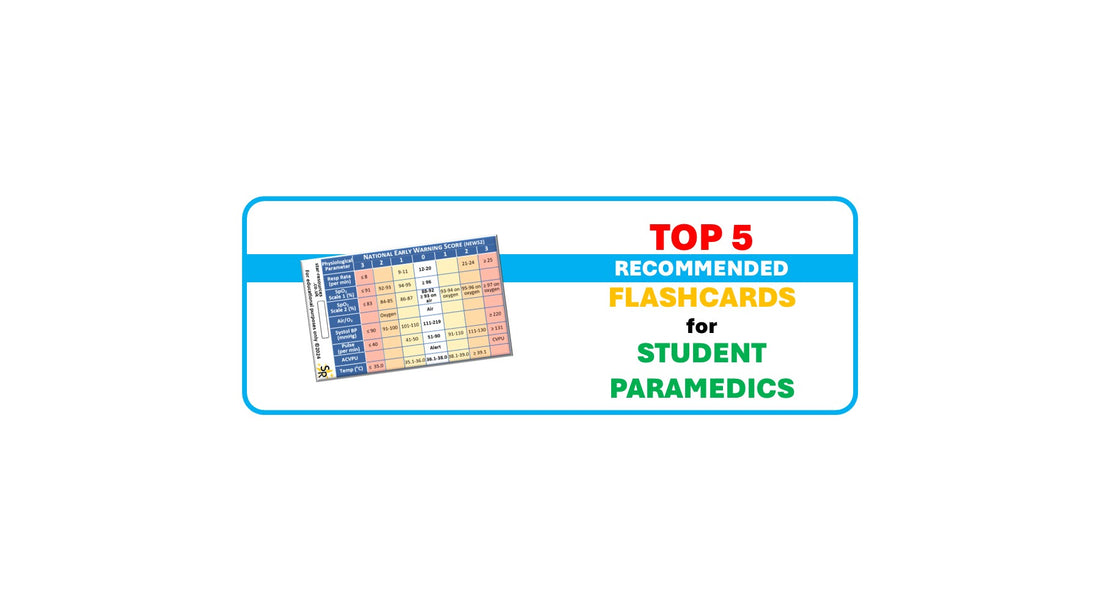
Top 5 Flash Cards for Student Paramedics
Share
Top 5 Flash Cards for Student Paramedics
As a student paramedic, preparing for placement can feel overwhelming. With so much information to absorb and the pressure of real-world scenarios, having quick references can be invaluable. Flash cards are a fantastic way to reinforce your knowledge and ensure you're ready for anything that comes your way. Here, we’ll explore the top five flash cards that every student paramedic should have in their toolkit, highlighting essential assessments and protocols.
1. NEWS2 (National Early Warning Score)
What it is: The NEWS2 tool is a vital assessment for identifying deteriorating patients. It helps paramedics quickly evaluate a patient's condition based on several physiological parameters.
Why it matters: This flash card provides a concise overview of how to calculate the NEWS2 score, which includes monitoring vital signs like respiratory rate, oxygen saturation, systolic blood pressure, pulse rate, and level of consciousness. Being familiar with NEWS2 not only aids in early identification of critical patients but also enhances your communication with other healthcare professionals.
Key Features:
- Easy scoring system (0-3 for each parameter).
- Clear guidelines on when to escalate care based on scores.
- A quick reference for common causes of abnormal scores.
2. GCS (Glasgow Coma Scale)
What it is: The GCS is a standardized tool for assessing a patient’s level of consciousness (LOC). It evaluates eye, verbal and motor responses to provide a score between 3 and 15. The higher the score the better the patient's LOC.
Why it matters: Knowing how to apply and interpret the GCS is crucial for paramedics, as it aids in assessing neurological function and determining the urgency of care required. This flash card outlines the scoring system and also provides a handy pain score chart and a pupil size measuring tool.
Key Features:
- Breakdown of eye, verbal, and motor responses.
- Baker-Wong Pain Scale
- Pupil measurement scale.
3. Adult Normal Vital Signs
What it is: This flash card summarizes the normal ranges for adult vital signs, including heart rate, blood pressure, respiratory rate, and temperature.
Why it matters: Understanding normal vital signs is fundamental for any healthcare provider, especially in emergency settings. This reference allows you to quickly assess and identify abnormalities, facilitating prompt intervention. The flash card also emphasizes how variations can indicate underlying issues, aiding in effective patient assessment.
Key Features:
- Clear ranges for each vital sign.
- Common names for deviations from normal.
4. Adult Sepsis Screening Tool
What it is: The adult sepsis screening tool is designed to help paramedics recognize the signs of sepsis early and act quickly.
Why it matters: Sepsis can progress rapidly and is a leading cause of morbidity and mortality. This flash card details the criteria for identifying potential sepsis, such as changes in vital signs and patient history. Being familiar with this tool allows you to implement immediate care protocols, improving patient outcomes.
Key Features:
- Quick checklist for sepsis symptoms.
- Guidance on initial interventions.
- Importance of timely recognition and escalation of care.
5. Adult Advanced Life Support (ALS) Algorithm
What it is: The adult ALS algorithm is a comprehensive guide for managing cardiac arrest and other life-threatening emergencies.
Why it matters: Familiarity with the ALS algorithm is essential for any student paramedic. This flash card outlines the step-by-step procedures for CPR, defibrillation, and medication administration, ensuring that you can act decisively in high-pressure situations. It serves as a critical reminder of the protocols you’ll need to follow during emergencies.
Key Features:
- Flowchart format for easy navigation.
- Key drugs and dosages for emergency scenarios during CPR.
- Possible reversible causes (H and T's)
Conclusion
As you prepare for your placement as a student paramedic, these top five flash cards—NEWS2, GCS, adult normal vital signs, the adult sepsis screening tool, and the adult ALS algorithm—are indispensable tools. They serve as a pocket paramedic guide, providing quick access to critical information that can help you make informed decisions in the field.
Investing time in reviewing these flash cards will enhance your confidence and competence, ensuring that you are well-prepared to handle the challenges of paramedic practice. Whether you’re assessing a patient’s condition or responding to a life-threatening situation, having these resources at your fingertips will make all the difference.
Remember, every call you respond to is an opportunity to learn and grow. Equip yourself with the knowledge and tools to provide the best care possible. Good luck on your journey to becoming a skilled paramedic!
